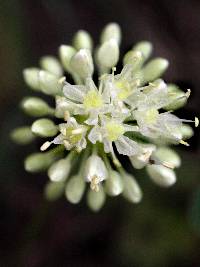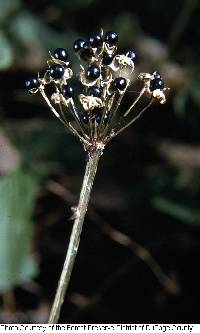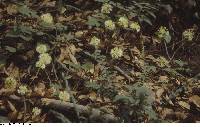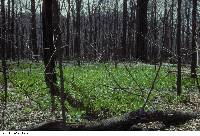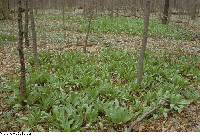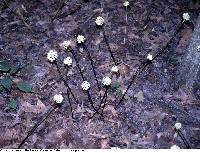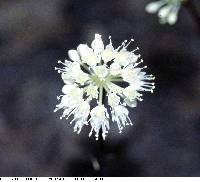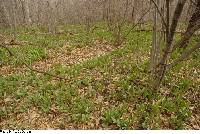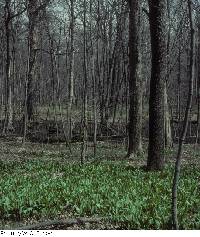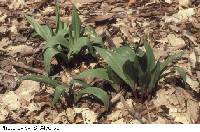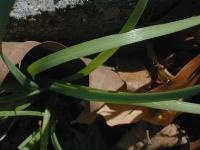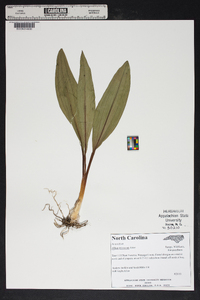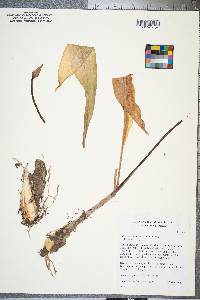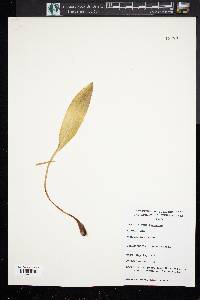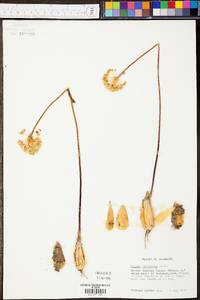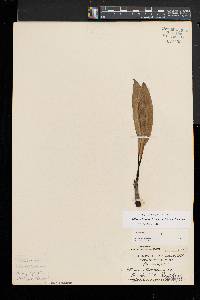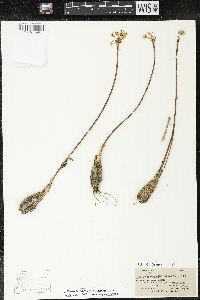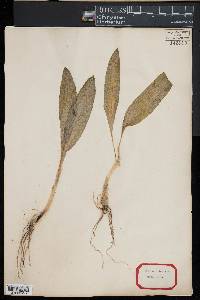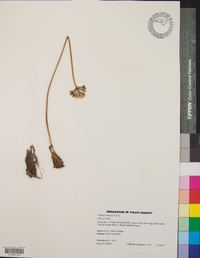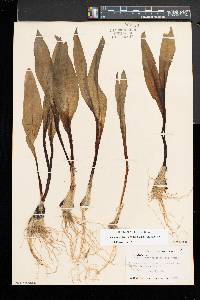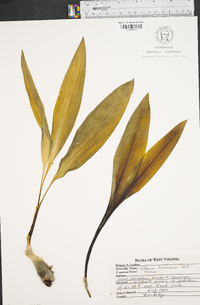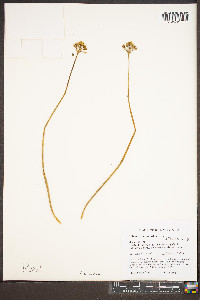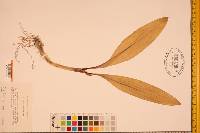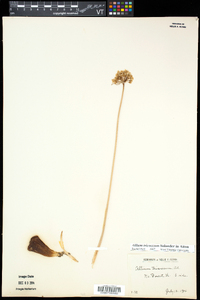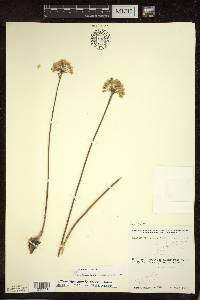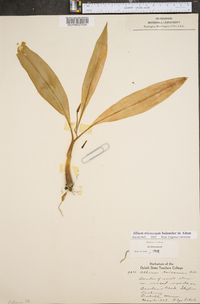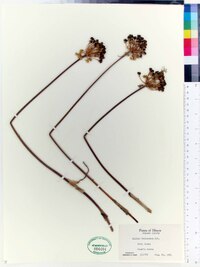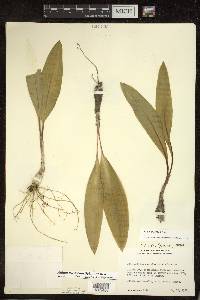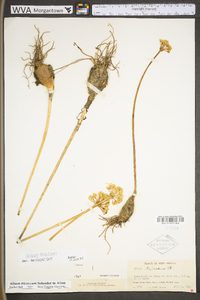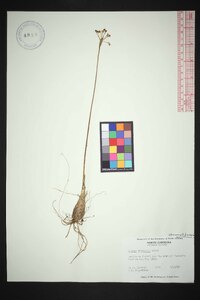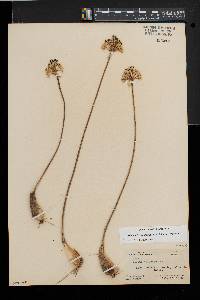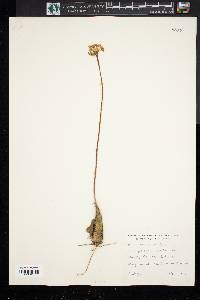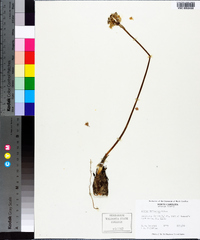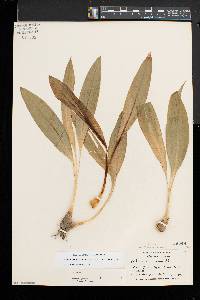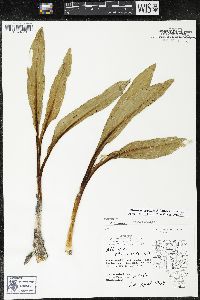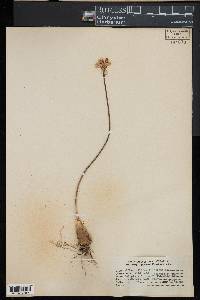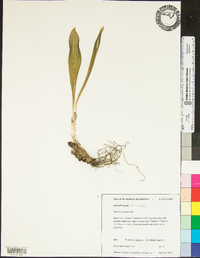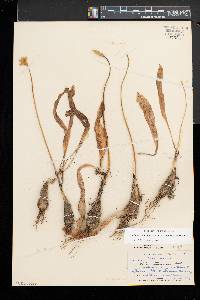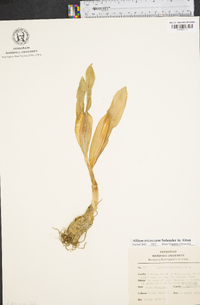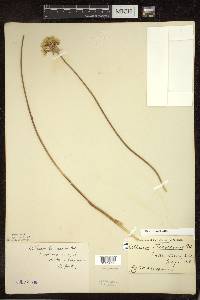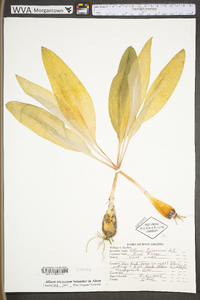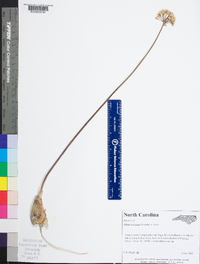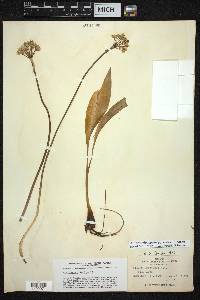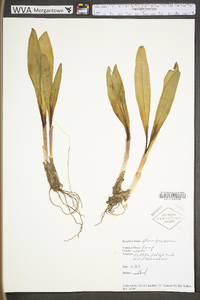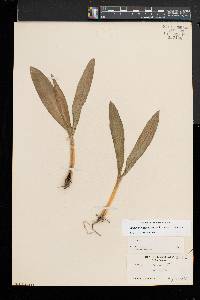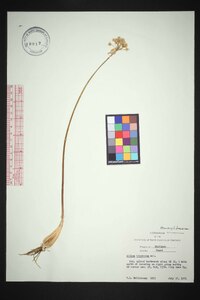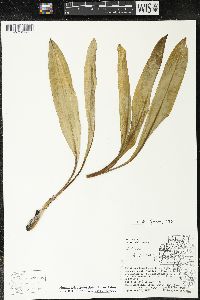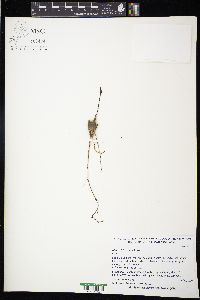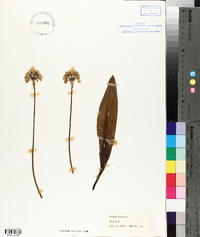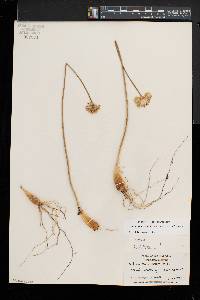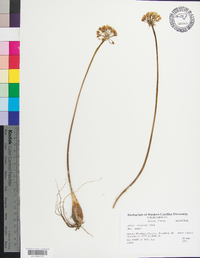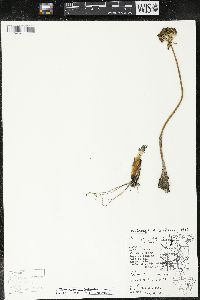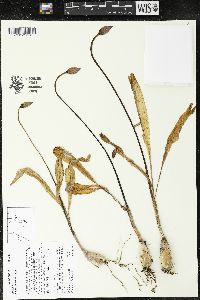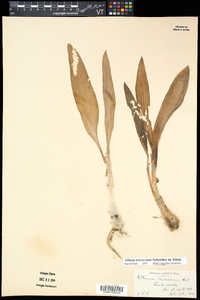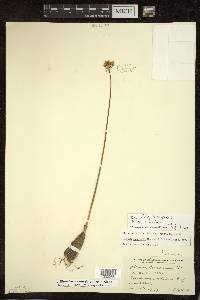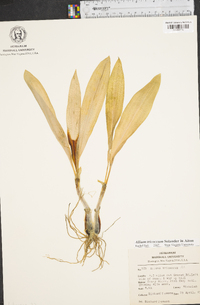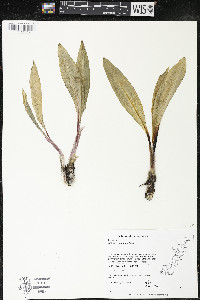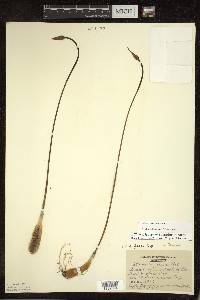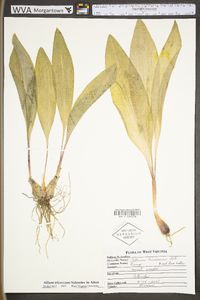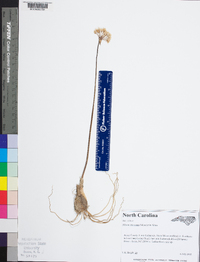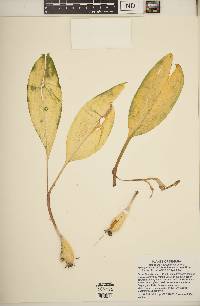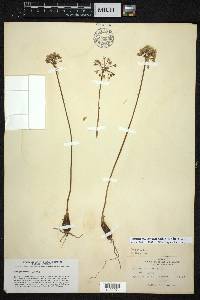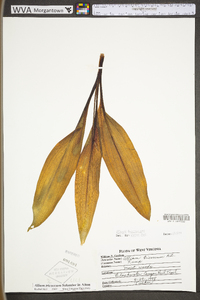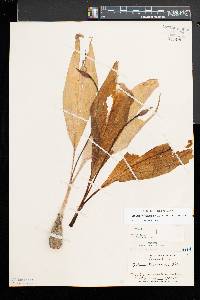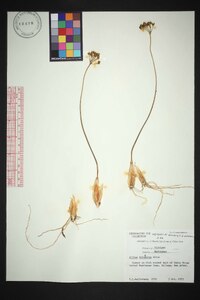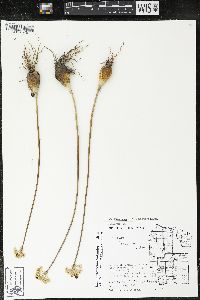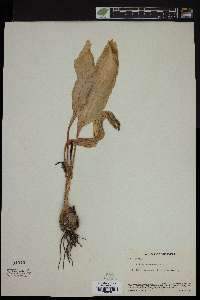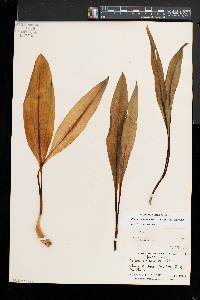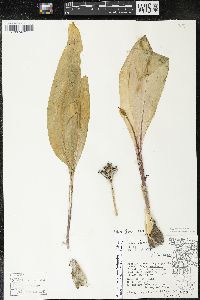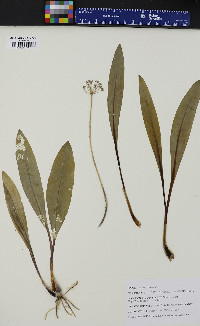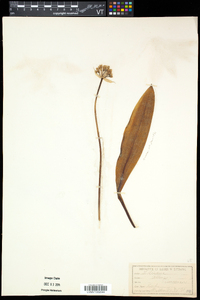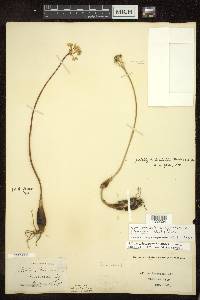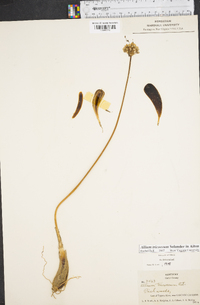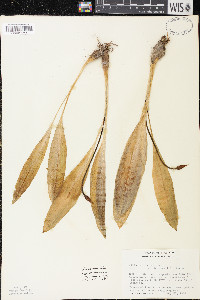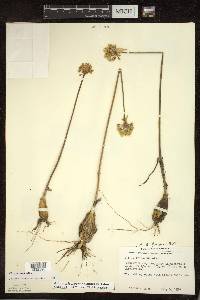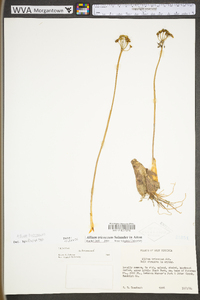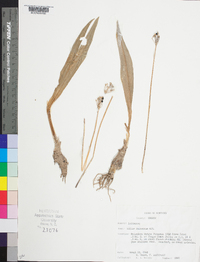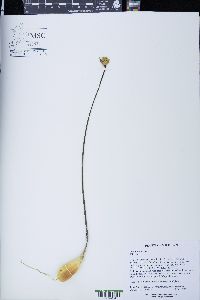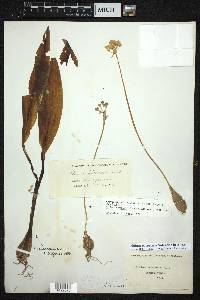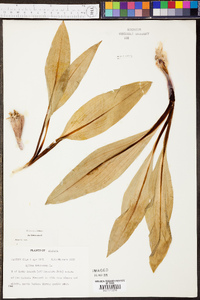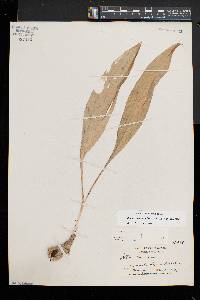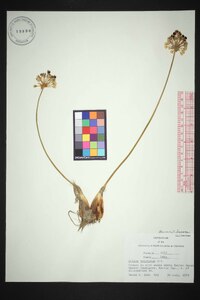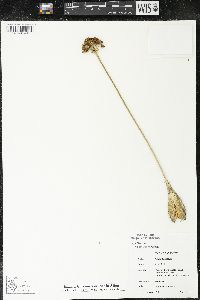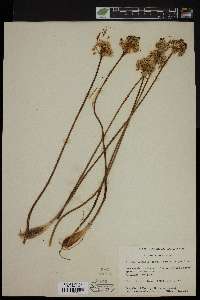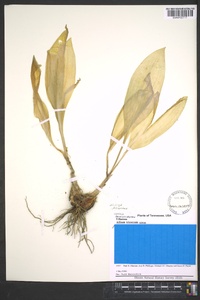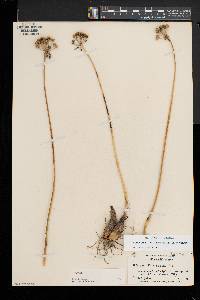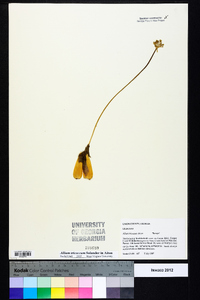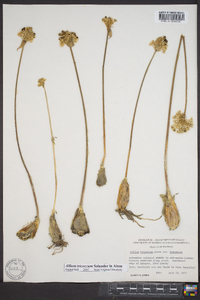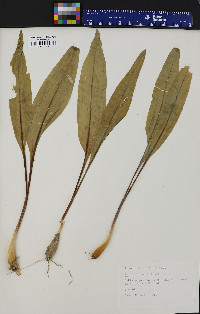Allium tricoccum
|
|
|
|
Family: Amaryllidaceae
Wideleaf Wild Leek, more...Ramps, Wild Leek
[Allium tricoccum var. tricoccum] |
Bulbs 2-6, usually borne on short rhizome, ovoid-conic, 4-6 × 1.5-3 cm; outer coats enclosing 1 or more bulbs, brownish to grayish, reticulate, cells finely fibrous; inner coat white, obscurely cellular, cells irregularly arranged. Leaves ephemeral, usually absent at anthesis, 2-3, basal; blade solid, flat, elliptic to elliptic-lanceolate, (3-)5-9 cm wide, tapering to long, slender petiole, margins entire, sheaths and petioles commonly anthocyanous. Scape persistent, solitary, flexuous distally, terete, (12-)25-35 cm × 2-4 mm. Umbel persistent, erect, loose, (15-)30-50-flowered, obconic to ± hemispheric, bulbils unknown; spathe bracts persistent, 2, ± 3-veined, lanceolate to lance-ovate, ± equal, apex acute, beakless. Flowers campanulate, 4-7 mm; tepals erect, white to cream or yellowish, oblong to ovate, ± equal, not withering in fruit, margins entire, apex obtuse; stamens ± equaling tepals; anthers white to light yellow; pollen white; ovary crestless; style included, linear, shorter than stamens; stigma capitate, scarcely thickened, unlobed; pedicel 10-20 mm. Seed coat shining; cells smooth. Distribution:: Flowering Jul--Aug. Moist ground in rich woods, depressions, streamside bluffs, and colluvial slopes; 0--1400 m; N.B., N.S., Ont., Que.; Ala., Conn., Del., D.C., Ga., Ill., Ind., Iowa, Ky., Maine, Md., Mass., Mich., Minn., Mo., N.H., N.J., N.Y., N.C., N.Dak., Ohio, Pa., R.I., S.C., S.Dak., Tenn., Vt., Va., W.Va., Wis. Perennial herb with two to six bulbs flowering stem 12 - 40 cm tall Leaves: two or three, basal, stalked, 15 - 20 cm long, 2 - 9 cm wide, flat, lance-shaped to elliptical, dying back before flowering time. Leafstalks long, narrow, and reddish. Inflorescence: an upright, more or less dome-shaped umbel of twelve to fifty flowers raised on a single narrow stalk and subtended by two, 2 - 3 cm long deciduous bracts. Flowers: white to cream-colored, 4 - 7 mm long, bell-shaped, with six tepals that remain even in fruit. Fruit: a three-lobed capsule. Bulbs: up to 6 cm tall, somewhat oval, and encased in a brownish or gray netlike coating. Similar species: The leaves of Allium tricoccum and A. burdickii are gone by flowering time, which distinguishes these species from other Allium in the Chicago Region. Also, its leaves are wide. The similar species A. burdickii differs by having much shorter leafstalks that are not reddish and leaves that are less wide. Flowering: mid-June to mid-August Habitat and ecology: Common in mesic woods, especially in the eastern part of the Chicago Region. Occurence in the Chicago region: native Notes: The name for the city of Chicago is derived from the Native American Miami-Illinois word "chicagoua," which means "striped skunk" and was also used in reference to the smelly wild leek, Allium tricoccum. The Miami-Illinois commonly named rivers after conspicuous plants in a watershed. "Chicagoua" was their name for the Chicago River. This name was later adopted for the town located at the mouth of the river, Chicago, which was incorporated in 1833. Etymology: Allium comes from the Latin word for garlic. Tricoccum is a combination of tri meaning three, and coccum meaning berry, which refers to the three-lobed fruit. Author: The Morton Arboretum Plants larger [than A. burdickii], the bulb ovoid-conic, mostly (1.5-)2-3 cm thick, its coat finely fibrous-reticulate; lvs flat, (3-)5-8+ cm wide, evidently petiolate, withering before anthesis, sheaths and petioles and often also the scape and bracts commonly anthocyanic; the scape (15-)25-35 cm long, the umbel erect, subtended by 2 ovate deciduous bracts; the unbel infl 2-3 cm, the fls (15-)30-50+, the fruiting pedicels (1-)1.5-2.5+ cm; range of the sp.; fl late, commonly July. Gleason, Henry A. & Cronquist, Arthur J. 1991. Manual of vascular plants of northeastern United States and adjacent Canada. lxxv + 910 pp. ©The New York Botanical Garden. All rights reserved. Used by permission. From Flora of Indiana (1940) by Charles C. Deam Infrequent to rare in moist, rich soil throughout the state, although there are no records from the southwestern counties. It seems to prefer slopes and woods near streams and it is most often found associated with beech and sugar maple. Indiana Coefficient of Conservatism: C = 7 Wetland Indicator Status: FACU Diagnostic Traits: strong-scented pungent herb; base of plant reddish; leaves petiolate, flat, 2.5 cm wide or more, withering before plants flower; inflorescences a scapose simple umbel, larger umbels with more than 18 flowers.
|
|
|
|


